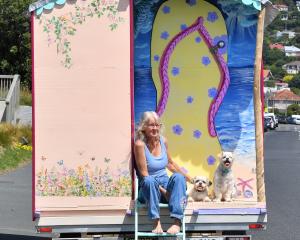Safety was the main reason for moving the north-bound section of Dunedin's urban cycleway from the left to the right hand side of the highway, NZ Transport Agency says.
But a daily cycle commuter says the change has created danger and confusion for cyclists.
Melanie Prescott, who contacted the Otago Daily Times, said, even though she had been knocked off her bike while in the cycle lane, she still felt ``a whole lot safer with the old system than the complete shambolic state of the new one''.
She asked why, when all the other cycle lanes in the city were on the left hand side of the road, the northbound cycleway had been moved to the right side from Albany St north.
And she questioned why there was no clear indication of where cyclists were meant to ride once they reached the end of the cycleway near Duke St and had to cross the intersection with Pine Hill Rd.
In response, NZTA projects team manager Simon Underwood said the cycleway was moved to the right hand side of the highway to try to reduce the number of ``cyclist interactions with buses at bus stops'' and to keep them out of truck drivers' ``left hand blind spot'', a key safety risk where trucks were turning left.
As to the lack of signage near the Duke St end of the northbound cycleway and the Pine Hill Rd intersection, Mr Underwood said it was intended cyclists would leave the cycle lane and travel across the Northeast Valley-bound traffic lane to reach the stop sign.
Then they could either go directly from the cycle lane, or travel along a shared path initially, depending on traffic conditions at the time.
``From feedback received, we're finding that cyclists are staying on the path - until it runs out,'' Mr Underwood said.
NZTA was looking at how to resolve the issue, including the most effective ways of letting cyclists know what they needed to do in that area.
Ms Prescott was also concerned about the shared footpath and cycleway around the Botanic Garden being ``ripped up, removing the barriers and separation, for a crappy piece of path to be relaid''.
Mr Underwood said the dividing kerb was removed because it ``trapped'' cyclists when there were pedestrians on the same side. It also confined them to a narrow pathway right beside the traffic lane.
When the northbound lane to the south of Albany St had been moved to the right side, it would take cyclists away from vehicles travelling in and out of supermarket car parks on the left side of the one-way north.
Moving the southbound lane to the right, apart from the section between Duke and Albany Streets, meant cyclists would avoid the Anzac Ave intersection with the one-way system near the railway station, the site of a cycling fatality in 2011.
Ms Prescott said the phasing of the lights at the Dundas St intersection was confusing and dangerous and cars could cut across the cycle lane to turn left.
But Mr Underwood said the lights were programmed so only a cyclist or a left-turning vehicle could proceed at any one time at the lights, and the new south-bound cycle lane would be defined by green-painted lanes and a series of concrete islands being installed at present.
He asked people to ``reserve judgement'' on the new layout ``until it's fully in place''.
Comments
Back to the hot controversy about whether cycle lanes, in general, increase safety or not. My own experience as a cyclist makes me think not. And that, in some cases, they may significantly increase risk. I don't think the DCC is being very responsible if they are allowing an uncompleted cycleway project to be used transitionally and are not absolutely sure that it will be much safer than the open road when completed and worth the cost and disruption to other road users. I just hope no cyclists are killed because of confusing road layouts.












